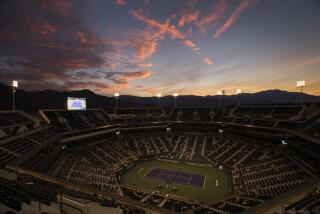Tennis on Upswing Down Under
- Share via
MELBOURNE, Australia — Sex and self-interest have floated the planet’s bargain-basement tennis tournament (a.k.a. the Australian Open) to heights never imagined Down Under.
Put Anna Kournikova and Patrick Rafter on a tennis court and they, the local customers, will come. Sniff the summer air of revival of tennis fortunes on an island that became as famous for Hoad and Rosewall as koalas and kangaroos, and they will form unprecedented lines at the box office. An attendance record of nearly half a million is in prospect, right up there with the other three majors: U.S., Wimbledon and the French. Nationalism and navels sell around here, female and male.
If Rafter’s feet hurt, his faithful limped. If he cramped, they drank more water. Sports patriotism is rife here, a pride in athletes from their lightly populated land beating the rest of the world in cricket, tennis, whatever. Even in their idolized days at the U.S. Open, Jimmy Connors and Chris Evert didn’t receive such a feverish reception at Flushing Meadow as Rafter here.
Kournikova and Rafter are gone, but their value not forgotten, and the previously poor sister of the Grand Slam quartet is planning for more success at Flinders Park. Another weatherproof stadium is in the offing to complement 15,000-seat center court with its never-a-rainout flip-top ceiling.
Curiously, when U.S. Tennis Assn. officials arrived a decade ago for the unveiling of the new acreage in downtown Melbourne, conveniently reached by foot, they didn’t fully get it. Yes, they were stricken by penthouse envy on inspecting the sky boxes that Flushing Meadow lacked. But how could they manage to spend $300 million or so on oversized Arthur Ashe Stadium without including a retractable roof that would guarantee their clientele and TV masters a daily show?
You could ask the same at a rain forest called Wimbledon where a multimillion-dollar new Court 1 was dedicated last year as though it were 1922 (the opening of the present Big W), a time when structural, on-demand protection from the elements was but a dream.
But the Aussies are ahead of everybody in presenting an attractive day at tennis. Nobody around here is asking, “Is tennis dying?” or “Can I get in? Can I afford to go?”
Center court is a more pleasing and intimate place to watch the game than Ashe Gulch, with its better view of Manhattan from the upper rim than the court. Moreover, tickets can be had, and within most people’s economic range. A grounds ticket is about $10 (U.S.), and a family plan lets in four for $30. Concession prices are about one-third those at the U.S. Open. Sure, it’s a smaller country in population and demand, but it does live up to the forgotten ideal, a “people’s tournament,” set forth in 1978 when then-USTA president Slew Hester built Flushing Meadow.
“This is the delightful sleeper of the four majors,” says Ron Sampson, a Boston lawyer who has attended the last three Grand Slam events. “It’s all so congenial and laid-back, no ticket problems. I just walk over from my hotel. Everybody wears shorts.
“And,” he laughs, “in Melbourne, which is a lot like Boston, and mainly sunny, you can get all the Slam weather, as we have this year: the rain of Wimbledon, the raw chill of Paris and the broiling humidity of New York. But they always play on [center court].”
The tournament, especially on the men’s side, has been as weird, but that can be engaging too, when reputations meant little.
“We’re coming back on the court, too, and people sense it,” says affable Hall of Famer and Davis Cup captain John Newcombe, a relic of the Aussie Mafia who so thoroughly dominated the game for a quarter-century after World War II.
“Rafter was a tremendous lift for us, winning the U.S. Open,” added Newcombe, the last Australian to win that tournament, in 1973. “He and Mark Philippoussis are young and getting better. The Woodies [Mark Woodforde and Todd Woodbridge] are still the best in doubles. Our women are weak, but there are some very good 14-year-olds. Pat can do more on court than thrill the teen-age girls every time he changes his shirt.”
Newcombe noted that the girls were also screaming amorously at 16-year-old Lleyton Hewitt of Adelaide in his singles and doubles matches.
Looking like a goldilocked re-run of Bjorn Borg, Hewitt is the longest-shot ever to win an ATP title, No. 550 when he beat Andre Agassi and Jason Stoltenberg to take Adelaide two weeks ago. Impressive, though losing in the Open’s first round, he pushed to five sets Daniel Vacek, who lost in five sets to Karol Kucera (Pete Sampras’ conqueror). Even Lew Hoad, Ken Rosewall, Rod Laver and Newcombe didn’t seem so advanced at 16.
“Lleyton’s a treasure,” Newcombe says. “I’m watching him closely, working him in with the Davis Cup boys so he gets the team spirit, the Aussie spirit.”
Wouldn’t bare-cupboarded U.S. captain Tom Gullikson like to have somebody like that around?
Agassi and Sampras could give the United States a Davis Cup winner, but neither seems that interested. Each picked the other to be in the final, and both have checked out of their hotel rooms prematurely. Was it hubris? Did Agassi count on Alberto Berasategui folding after he won the first two sets? Was Sampras cavalier in his new year’s preparation--an exhibition event--while Kucera was getting tournament tough, winning at Perth and Sydney?
Sampras’ scouting of Kucera was a memory of a routine win over the Slovak at Wimbledon two years ago. “He was erratic, double-faulted a lot.”
Andre Bucko, a Slovak journalist, derided Sampras in print: “Pete’s strategy was to wait for Karol to double-fault. It did happen. Three times to go with 18 aces.”
If you wanted scintillating American presence, it was Venus and Serena Williams. Green but winning in carefree personalities and bludgeoning strokes, they carried the town. Venus, showing inexperience, might have won the title if she’d put away a routine break point shot when she led a reeling Lindsay Davenport, 6-1, 15-40. Never mind, the Venus and Serena show is just getting launched.
They’ll all be back, agreeing that life is great in the world’s sunny basement, too good to miss.
More to Read
Go beyond the scoreboard
Get the latest on L.A.'s teams in the daily Sports Report newsletter.
You may occasionally receive promotional content from the Los Angeles Times.










